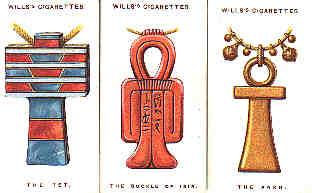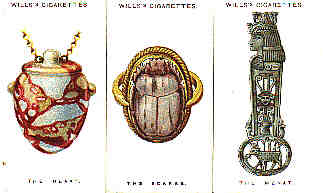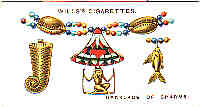Your path =Home>Uses of Beads>Religion and Amulets > Charms
Lucky Charms
Advertising cards issued by W.G. & H. O. Wills of Bristol & London 1923.
Page 3 of 5.
Part Three: Egyptian Amulets

Cards 26, 29 and 15
Three Common Pendants
From left to right they are the Djed (Tet), the Tyet (Girdle or Knot of Isis) and the Ankh. The Djed is a pre-dynastic symbol for stability. The Tyet perhaps and the Ankh definitely represent life.
The Djed and Ankh are poorly drawn here. The Djed should have small projecting "shelves" on each side at the top. The loop of the Ankh is too small and too rounded.

Cards 27, 20 and 30
Three Common Charms
From left to right. The heart, worn for health and buried with the dead. The scarab: bead, amulet and token of friendship. The Menat, protector of women and a love charm.
The heart (here apparently cut from marble) was worn for health. The human heart was considered the seat of the soul and was weighed in the afterlife to determine the person's worth. Heart amulets were also buried with the dead.
The scarab, usually carved from soapstone (steatite), was worn as a bead and also served as a seal. The inscriptions on the back were used to identify people and belongings. Large scarabs were also made to announce royal marriages and the like to the public. Scarabs served as charms and were also just exchanged by friends as tokens of their love. The dung beetle, believed to roll the sun across the sky, got quite a lot of attention in Egypt.
The Menat was a charm of Hathor, the Goddess of the Sunrise. It was worn especially by women, for whom Hathor was a favorite. It served to protect the wearer and was also something of a love charm. (So says the Wills people.) This one is uncommonly elaborate. Usually only the head of Hathor was depicted as the amulet.

Card 31
Necklace of Charms
I think this is a concoction from several collections. At least it has some glass beads, even though they are a rather dull shape for ancient Egyptian jewelry. Golden cowries were popular, usually worn by women. The center pendant has an inlaid lotus (symbol of understanding) with the symbol for eternity and his outstretched hands underneath. The fish symbolized the Nile and is a hand amulet against the Evil Eye. The golden lock of hair may represent royalty. Wigs were popular with the Pharaohs.
Last Gallery PageNext Gallery Page
__________________________________________________
Small Bead Businesses | Beading & Beadwork | Ancient Beads | Trade Beads
Beadmaking & Materials | Bead Uses | Researching Beads | Beads and People
Center for Bead Research | Book Store | Free Store | Bead Bazaar
Shopping Mall | The Bead Auction | Galleries | People | Events
The Bead Site Home | Chat Line | Contact Us | Site Search Engine | FAQ